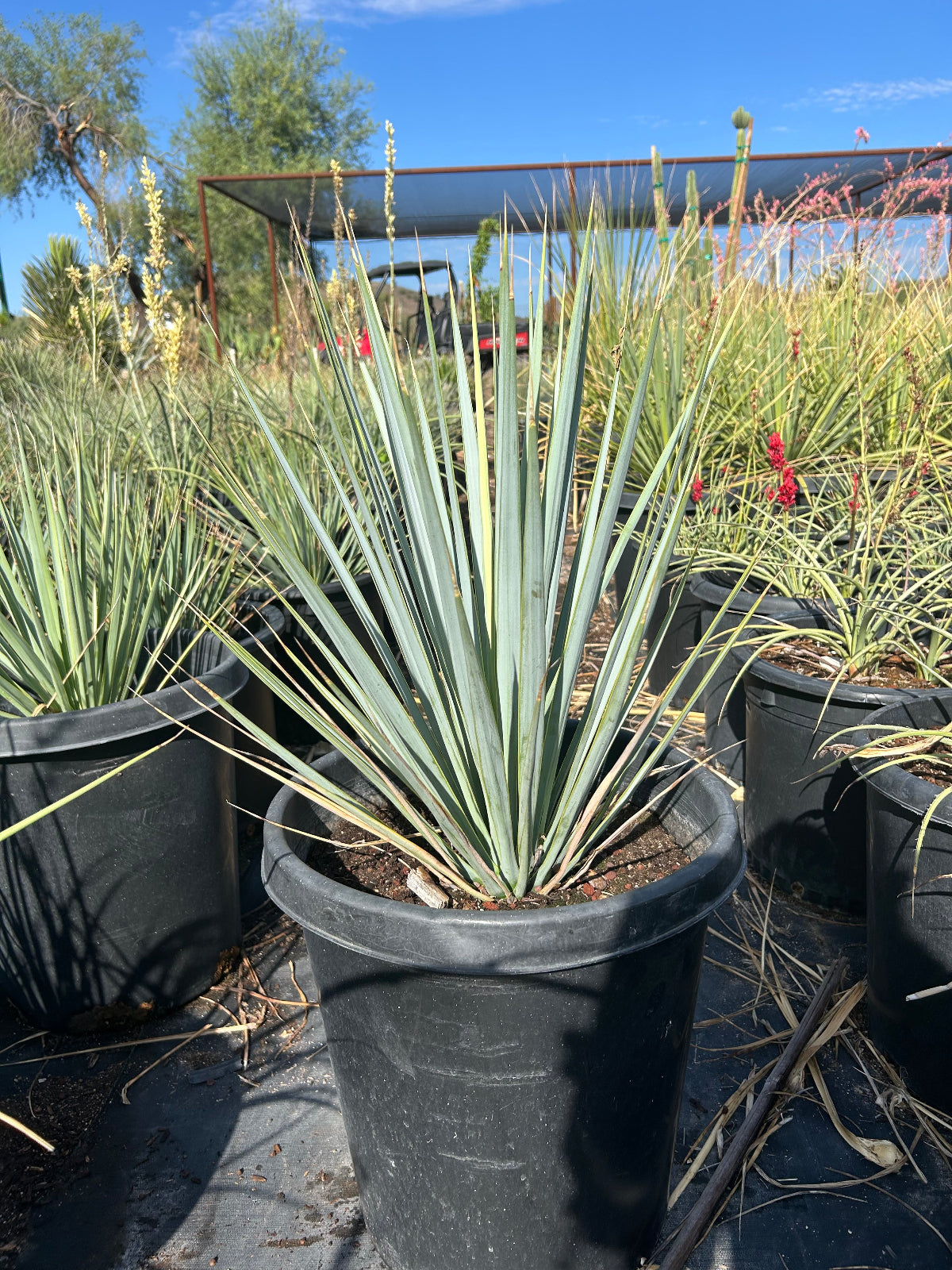My Store
Blue Yucca
Blue Yucca
Couldn't load pickup availability
Plant Type: perennial, evergreen succulent shrub (tree-form yucca)**
Plant Height: 6–12 feet (can reach up to 15 feet in maturity)**
Spread: 4–6 feet
Flower Color: creamy white (large bell-shaped clusters)**
Sun Exposure: Full sun
Blue Yucca / Yucca rigida: A Stunning Silver-Blue Desert Sculpture of Strength and Elegance
Yucca rigida, commonly known as the Blue Yucca or Rigid Blue Yucca, is one of the most visually striking yucca species—celebrated for its brilliant icy-blue color, symmetric form, and towering flower spikes. Native to northern Mexico, it thrives in hot, arid conditions and brings refined structure and vibrant contrast to Arizona landscapes.
Resembling a smaller, softer version of the Joshua Tree (Yucca brevifolia), this species offers architectural impact without the bulk—making it an exceptional choice for both residential and commercial desert designs.
Key Features of Yucca rigida
The Blue Yucca forms a dense rosette of narrow, rigid leaves that are blue-gray to silver-blue, each leaf reaching 2–3 feet long and tapering to a sharp terminal spine. The leaves radiate symmetrically around a central trunk, creating a clean, spherical crown atop a single or multi-trunked base.
In late spring through summer, mature plants produce massive upright flower stalks rising 3–5 feet above the foliage, densely packed with creamy white bell-shaped flowers. These blooms are both ornamental and pollinator-friendly, drawing bees and moths to the garden.
With age, Y. rigida develops a woody trunk that can reach 6–10 feet tall, topped with one or more blue rosettes that resemble living sculptures. Its metallic-blue hue remains intense year-round, providing color and contrast even in the harshest Arizona sun.
Growing and Care Tips
Yucca rigida thrives in full sun and sharply draining soil—preferably a mix of sand, decomposed granite, and rock. It performs best in open, exposed areas where it receives all-day light and reflected heat.
Water deeply but infrequently during the first few months after planting—typically every 14–21 days depending on heat and drainage. Once established, it becomes highly drought-tolerant, needing irrigation only once every 4–6 weeks in summer and rarely in winter. Overwatering can cause crown or root rot.
This species is cold hardy to about 10°F, tolerating brief frost and light freezes without damage. It’s slower-growing than smaller yuccas but long-lived, with each trunk persisting for decades.
Pruning is minimal—simply remove spent flower stalks and dead leaves for a clean, refined look. Wear gloves and long sleeves when trimming; though the leaves are rigid, they’re not as hazardous as Yucca aloifolia.
For containers, use a tall, heavy pot with gritty cactus mix to accommodate deep roots and ensure proper stability.
Landscaping Uses
The Blue Yucca is a statement plant ideal for modern desert, Southwestern, and architectural landscapes. Its icy-blue foliage and upright form make it perfect for entryways, focal points, and sculptural groupings.
It pairs beautifully with Golden Barrel Cactus, Blue Glow Agave, Desert Spoon (Dasylirion wheeleri), and Totem Pole Cactus (Pachycereus schottii monstrosus)—creating visually balanced combinations of shape and color.
Use it as a standalone feature in minimalist designs or in clusters of three for rhythm and repetition. It also makes an excellent companion plant for warm-toned rock or rusted steel, where its icy hue provides perfect contrast.
Under landscape lighting, Y. rigida’s glaucous blue leaves reflect a cool, ethereal glow, making it one of the most striking night-time features in a desert garden.
Summary
The Blue Yucca (Yucca rigida) is a desert showpiece—bold, sculptural, and enduring. With its shimmering silver-blue leaves, tall flower spikes, and stately form, it brings elegance and permanence to Arizona landscapes. Requiring almost no maintenance once established, it’s an ideal choice for homeowners and designers seeking a refined architectural accent that thrives in sun, heat, and drought.
Three Timbers Installation Guide (Feel Free to Follow):
Yucca rigida Planting Guide:
Location: Full sun; select an open, exposed site with 8–10 hours of direct sunlight daily. Handles reflected heat and wind with ease.
Soil: Use a sharply draining cactus mix blended with decomposed granite, sand, or pumice. Avoid compact or moisture-retentive soils.
Spacing: Allow 5–8 feet between plants or nearby structures for airflow and mature spread.
Planting Depth: Keep the root crown level with or slightly above soil grade. Avoid burying the lower leaves or trunk.
Support: None required; naturally upright and self-supporting once established.
Watering Guide:
Watering After Planting: Water deeply once after installation to settle soil. Then allow it to dry completely before watering again. During the first 3–4 months, water every 14–21 days depending on heat and soil drainage.
When is the Plant Established? Yucca rigida is considered established after 9–12 months, once color deepens and new top growth appears.
Watering Once Established: Water every 4–6 weeks in summer if no rainfall occurs. In winter, watering is rarely necessary.
Drip Irrigation Setup: Install one low-flow emitter (1–2 gallons per hour) about 12–18 inches from the base, angled outward. Run sparingly and allow full drying between cycles.
General Watering Tips: Always confirm soil dryness before watering again. Overwatering is the most common cause of crown rot. A top dressing of decomposed granite or gravel enhances drainage, stabilizes soil temperature, and highlights the yucca’s stunning blue hue. Keep gravel several inches from the base for airflow and long-term health.
Share














